
J/105 North Americans and the Winning Secrets of Randy Hecht
Want to sail 11 tough races in a big J/105 fleet on the Berkeley Circle in 10 minutes from the comfort of your home or office? Watch Vince Casalaina’s excellent summary video of one of the most competitive regattas on the Bay.
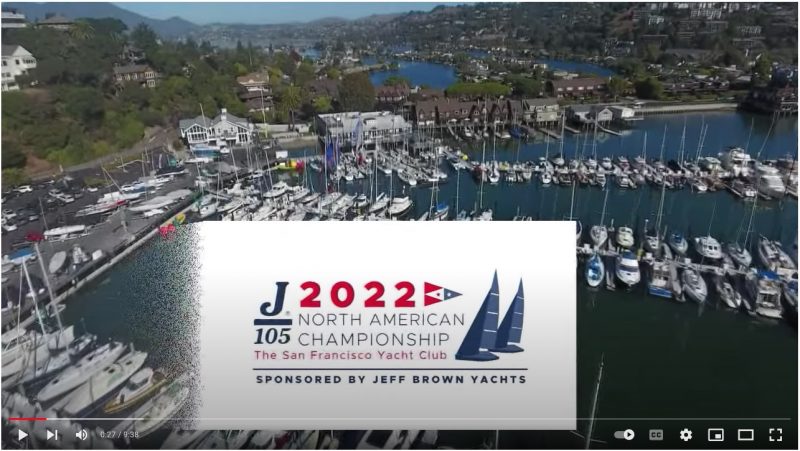
In a tough fleet of 28 boats, Rolex Big Boat Series winner Randy Hecht and his crew aboard Niuhi also won the J/105 North Americans an impressive 33 points ahead of the second-place boat, Blackhawk. San Francisco Yacht Club hosted the regatta on September 26-October 2.
We spoke with Randy at RBBS, and he shared a couple of his winning secrets. One is the credit he gives to Russ Silvestri and the rest of his crew. One of Russ’s prime directives to the crew on board was, “Do your job,” a focus that clearly helps. Another was the TackingMaster he was wearing on his wrist. He credited this year’s ILCA 6 Masters Worlds champion in the Legends division, Chris Boome, for bringing this to his attention. He also mentioned cracking off the jib slightly instead of just ragging the main upwind in a big breeze. Lead aft?
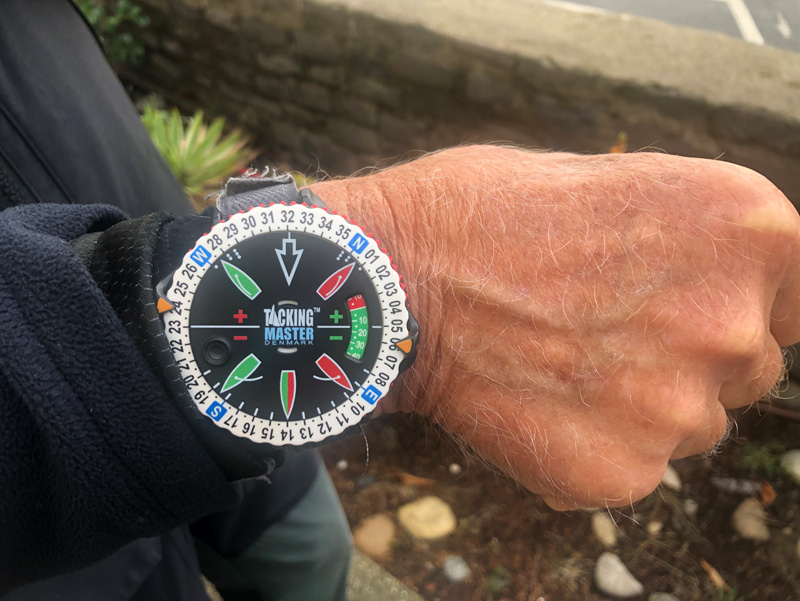
San Francisco Bay is famous for strong, consistent breezes. (Though “consistent” doesn’t mean there isn’t a favored end of the line, and the concept of consistency may lull some into thinking there aren’t too many shifts.) Enjoy the video and take those tips from a winner to the top of your class.
Proposed New Marine Sanctuary off California’s Central Coast Progresses
We’ve been keeping an eye on the progress of a proposed new national marine sanctuary off California’s Central Coast: the Chumash Heritage National Marine Sanctuary. The nomination was made in 2015 by the Northern Chumash Tribal Council (NCTC) as a way to protect the region’s marine resources and ecosystems, stimulate research and economic growth, and protect the Indigenous communities’ cultural values.
The proposed sanctuary stretches along 152 miles of coastline adjacent to San Luis Obispo and Santa Barbara counties. It would provide a haven for marine mammals, invertebrates, sea birds, and fish. It would also create an overarching framework for community-based spatial management for many threats, and recognize Indigenous and tribal history and culture in the area.
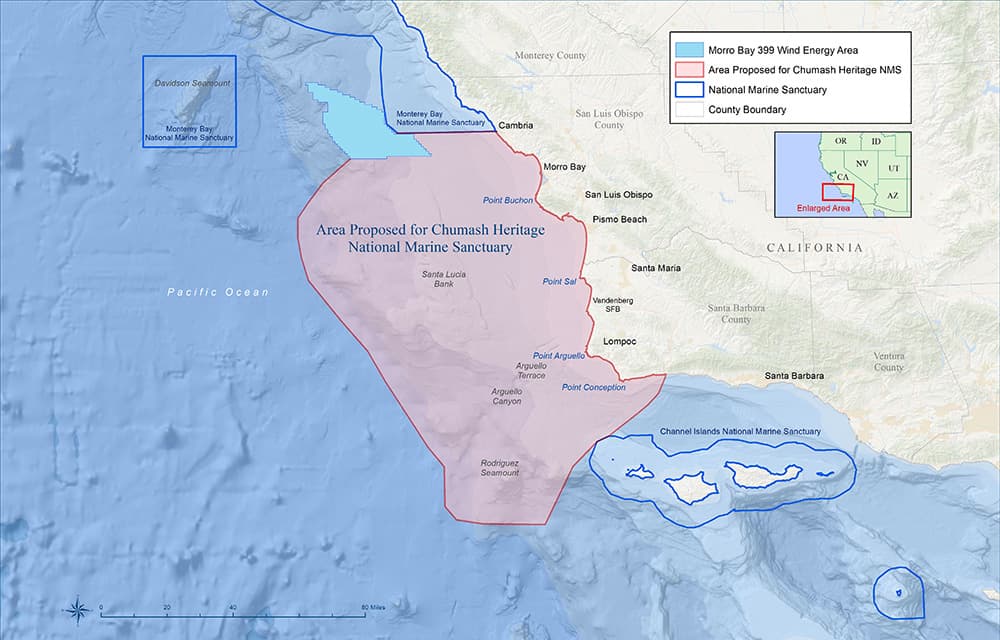
The area is known for its extensive kelp forests, vast sandy beaches and coastal dunes, and wetlands serving as nursery grounds for numerous commercial fish species, and includes important habitat for many threatened and endangered species such as blue whales, southern sea otter, black abalone, snowy plovers, and leatherback sea turtles. Numerous threats have been identified to resources within the proposed area, and proponents believe a national marine sanctuary offers solutions in guiding coordinated and comprehensive ecosystem-based management, including organizing and stimulating marine research, education, stewardship, tourism, and recreation, as well as providing protection for important native cultural sites.
The proposed area also holds many nationally significant shipwrecks throughout this maritime landscape. One such wreck is the USCG Cutter McCulloch, which sank off Point Conception after colliding with the passenger steamship SS Governor on June 13, 1917.
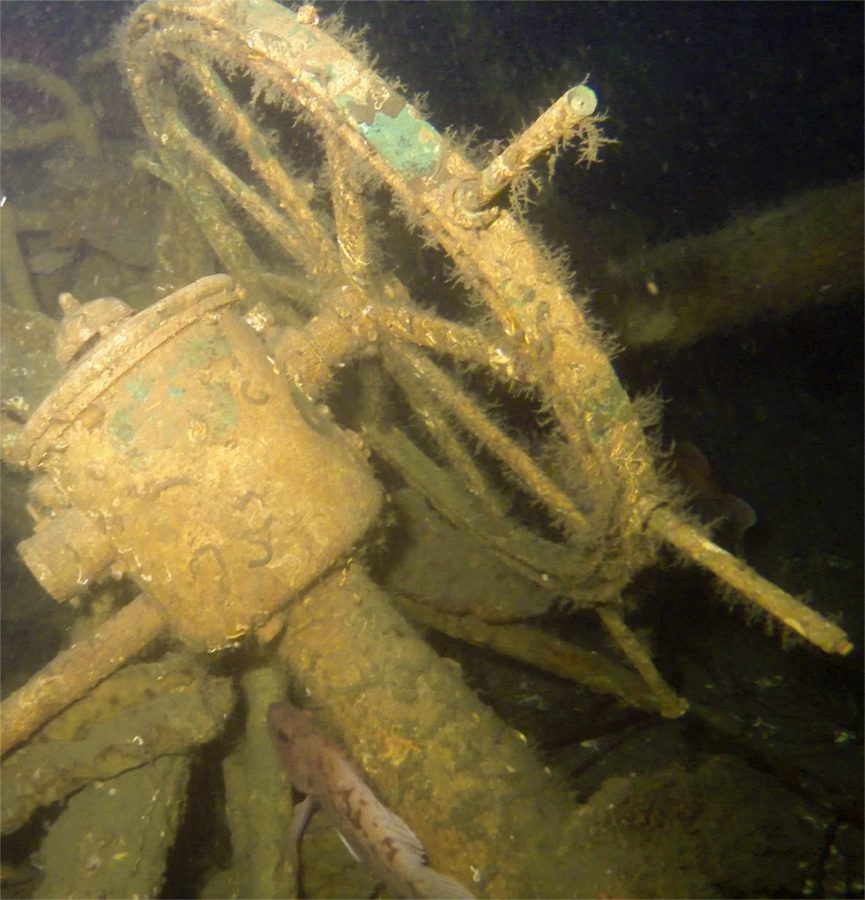
At this point the “Designation Process,” as it’s called, is still in the early stages. The process, broken down into six steps, is currently at step two — Review of Public Comments and Preparation of Draft Documents. The plan is to have this completed sometime between December and the early part of 2023, at which point it will be released for public comment. The end goal is to have the sanctuary “designated” by winter 2023, so around a year from now. Clearly things don’t move quickly, and when you consider that the sanctuary was proposed in 2015, well, it’s still less than a decade-long process, so far. That said, we do appreciate the efforts of NOAA and all the individuals and partner agencies involved; change is never easy, and on a large scale it’s even harder to instigate.
There are numerous marine sanctuaries in California, many of which we’ve written about in the past. We’ll continue to follow the progress of the proposed Chumash Heritage National Marine Sanctuary. In the meantime, if you’d like to know more about the proposal, go to https://sanctuaries.noaa.gov/Chumash-heritage/.
Westwind Yacht Management — Washing, Waxing and Varnishing
Westwind Yacht Management: Premiere Yacht & Fleet services for the San Francisco Bay Area.
The Route du Rhum Floodgates Open
The floodgates are opening in Pointe-à-Pitre, Guadeloupe, for the Route du Rhum, with IMOCA 60 monohulls finishing in rapid succession. The huge fleet of Class 40s is now just two days away.
Ocean Fifty Trimarans
After the huge maxi-trimarans blitzed across the ocean in record pace, the next class to reach the idyllic Caribbean island were the Ocean Fifty trimarans. Approaching Guadeloupe in varying strengths of tradewind breeze, the battle for Ocean Fifty supremacy raged until the very end. The legendary Erwan le Roux and Koesio sailed farther west before jibing than chief rival and race leader Quentin Vlamynck on Arkema 4. Coming in at a hotter angle and a higher speed than Arkema 4, le Roux sailed a straighter, faster line and secured a divisional win by just over 14 minutes after nearly 11 days of racing. Sébastien Rogues on Primonial came home about six hours later to round out the podium.
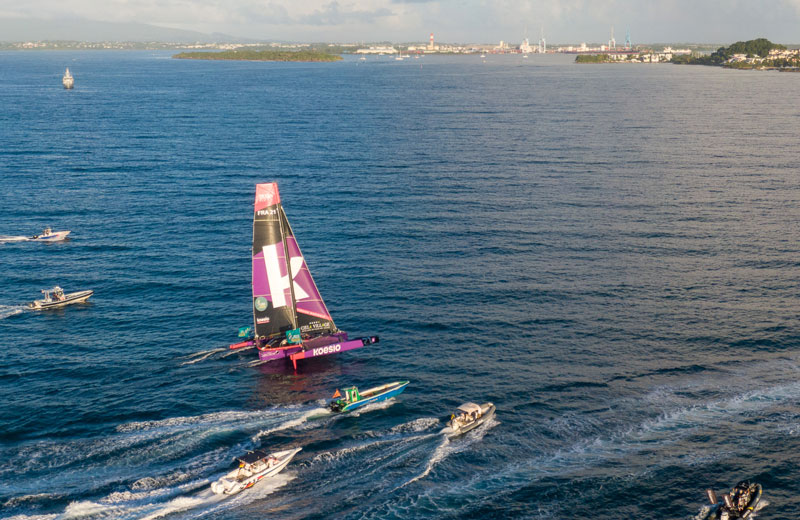
IMOCA 60 Division
Likewise, the IMOCA fleet saw a thrilling battle with more late-race heroics as well. After looking dominant early in this race, Charlie Dalin and Apivia’s lead began to be threatened by Thomas Ruyant and LinkedOut while approaching Guadeloupe. Seemingly faster when running deep and jibing dead-downwind, LinkedOut made a pass and gained an advantage before extending to a slight lead over Apivia. Holding that lead until the finish, Thomas Ruyant has won the IMOCA division in the 12th Route du Rhum by about two hours. Jérémie Beyou and Charal 2 finished a further one and a half hours behind to round out the podium.

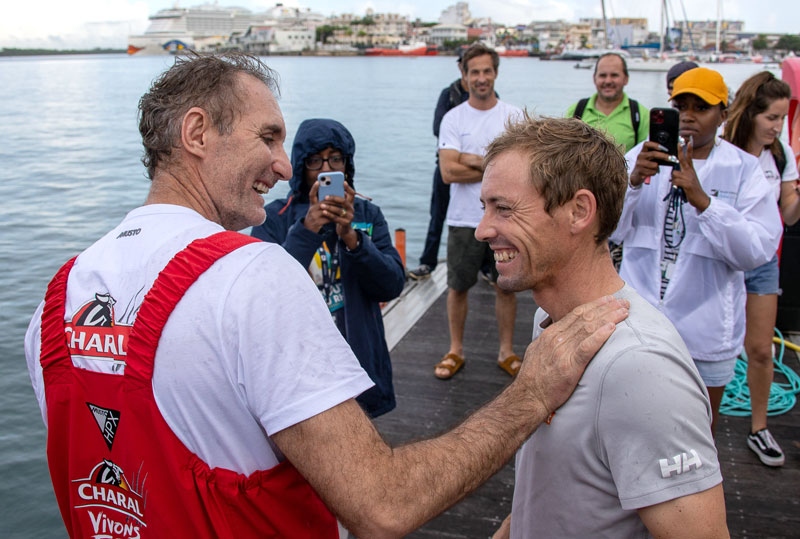
With San Francisco company Medallia’s skipper Pip Hare making a remarkable comeback to 10th place, three female skippers are now in the top 10, including Justine Mettraux on Teamwork.net in seventh and Isabelle Joschke on MACSF in ninth. IMOCA 60s will be finishing the race one after another for the next handful of days.
Class 40 Fleet
Yoann Richomme on Paprec Arkéa has continued to extend out in the Class 40 division and now has a lead of more than 100 miles over Corentin Douguet on Queguiner-Innoveo. With Italian and Swiss skippers in third and fourth place as of this writing, the Class 40 podium could end up being quite international. Adding to the international flair in the division, Bay Area native Alex Mehran looks poised to turn in an impressive result in this Route du Rhum. Mehran sails in 14th position, though he has the potential to still gain or lose several places. It’s still all to play for in the final stages of this race! American Greg Leonard on Kite is having a good race as well, and currently lies in 24th place.
Most of the fleet is still at sea. Many great battles are drawing to a close in the next handful of days, so make sure to stay tuned to the website, the tracker, and the social media feeds.
Not Much Clarity on New Zealand’s Yacht Immigration Rules
A few weeks ago we wrote about New Zealand’s current immigration policy, which stated that immigrant yachts that leave the country cannot return until after the same amount of time they were in the country — put simply, if you were there for six months and then left, you would not be allowed to return until another six months had passed. That doesn’t sound too bad, under normal circumstances, but when you throw COVID lockdowns into the mix, things take an interesting turn.
Francene McLaughlin’s was one of several hundred yachts that had been stranded in New Zealand (NZ) during COVID, and upon leaving the country in June this year, she was told she could not return for another two years. Francene wrote to us in the hope of finding some information about any changes to this rule that would enable her to return sooner. And while we didn’t have a lot of news for her when we wrote about her plight, we did later receive an email from Viki Moore of Island Cruising NZ. Ms. Moore had read our story and wrote to us with some information that, while not solving the problem, does indicate that others are also addressing the issue and looking for solutions.
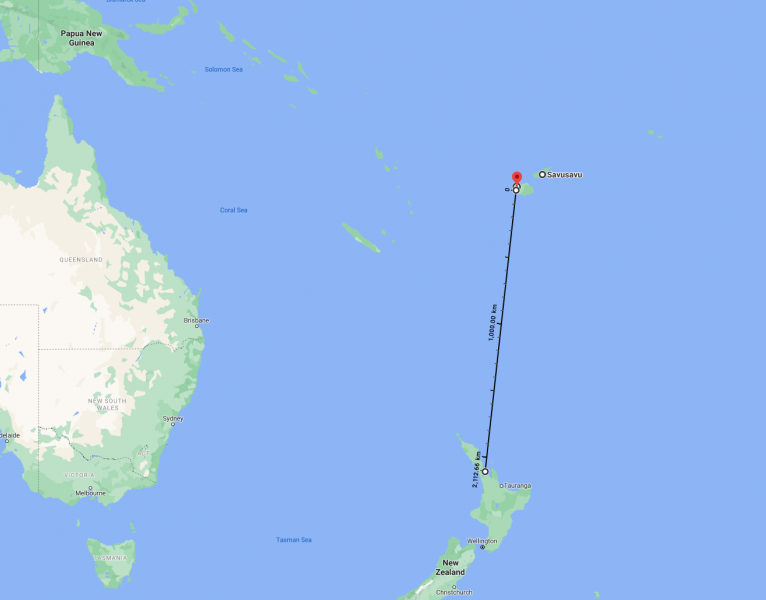
In 2020 Moore started a Facebook group called “Sailors with COVID Immigration Issues NZ.” The group has more than 360 members, all of whom are in a situation similar to Francene’s.
“Many of the people in the group had been stuck in New Zealand over lockdown, unable to leave as they wouldn’t have been able to return to get back to their boats. Earlier this year we spoke to the local Member of Parliament about the issue of those sailors not being able to return to New Zealand due to the current visa policy. Our appeal to the Minister of Immigration was supported by many of the local marine businesses who also valued the returning sailors who had spent many years in NZ and the Pacific, spending six months here in New Zealand and then six months away in the South Pacific, which they were entitled to do. Sadly our appeal was declined as the reasons for wanting to return in NZ were not considered to be exceptional circumstances.
“The immigration law states that anyone who has been in New Zealand for 12 months or more must remain outside New Zealand for 12 months before a further application for a visitors visa may be approved,” Moore wrote.
“She [Francene] has got a few options.
- Leave the boat in Fiji and fly home and apply to return to NZ in October next year (this is what most of my people have done).
- Sail to Australia instead, then back to the South Pacific in May and back to NZ in October next year (a few others have done this too).
- Apply for a visa, get declined and then appeal to the Minister of Immigration, if she has some exceptional reasons as to why she should be able to come back to NZ (but I doubt she’d get this approved as no one to my knowledge was able to when we appealed to the Minister in May this year). This process can also take months.”
We forwarded this information to Francene, who at the time of her response said they were thinking about heading back to the US, “after 28 years floating around the South Pacific.”
That said, it sounded as if the decision was yet to become action. If you or anyone you know is in a similar situation regarding New Zealand, you could reach out to Viki Moore at Island Cruising NZ. You could also look up these websites: Reopening the New Zealand border | Immigration New Zealand and New Zealand visas | Immigration New Zealand.

